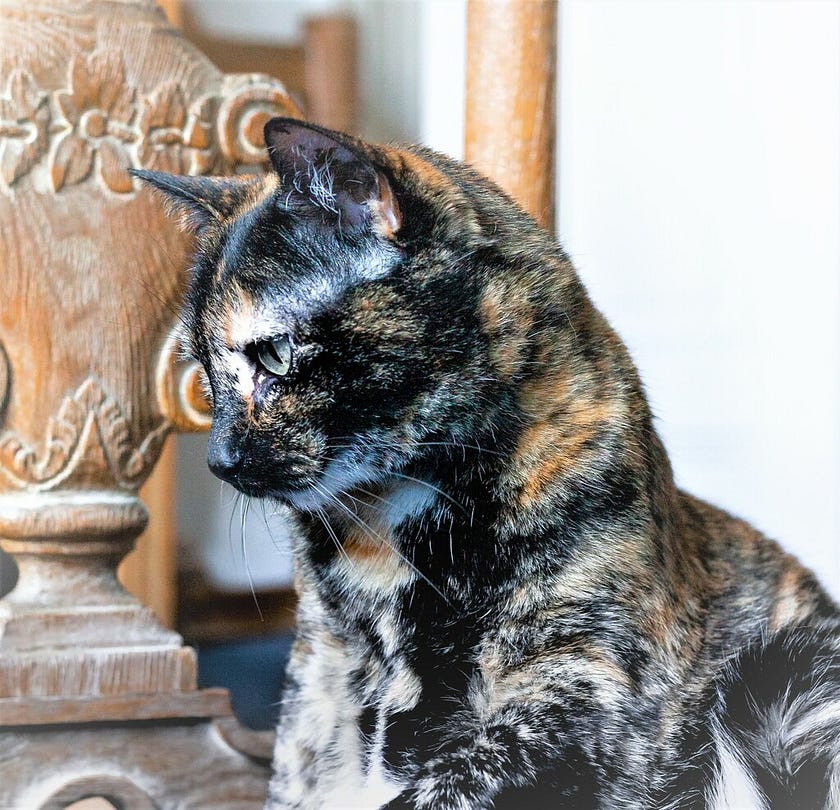Living with a cat or any pet is an exceptional experience. Cats don’t do anything you tell them, they don’t even take suggestions. In the photo below is Stubbs and I.
I live with three cats. Recently, Stubbs became very sick, I didn’t notice at first. I just thought she was tired and wanted to spend a little time resting, or be alone on the bed. But when I took a good look at her, I saw that she wasn’t closing her eyes, and it appeared as if she was suffering.


Often, animals won’t show you that they are in pain. They don’t moan about pain, or howl and bicker the whole time.
I’m pretty sure that’s an instinct. If a cat was in the wild living in a herd, or family of cats, it would have to be strong and able, all of the time. Animals have to survive, so they form packs and hunt or forage for food.
If a cat was injured or sick, it might attract other predators, or slow the pack down. The whole pack can’t risk survival for a weak animal.
In spite of that, cats and other domestic animals are able to adapt. That means they learn about their environment and make use of the resources they find. I know mine do. They use my bed as theirs, they think the sofa is a cat tree, and I am nothing but a useful heater in the winter. It’s always my job to warm the bed before they decide to settle down for the night.
When I get up in the morning, I get coffee, sit at the kitchen table, and one after the other they trot into the kitchen and check the food bowl – just to be sure I’ve freshened it up.
Then, each cat will take turns in getting an ear rub, back massage, followed by a lot of praise from me.
Stubbs was sick, so I took her to a vet. The first vet looked her over quickly, and pointed out that she couldn’t walk, not even stand up. I told him that I knew this, that’s why I brought her to him. It didn’t take long for him to start talking about her quality of life, and that she might be better off if we ‘put her to sleep’. He was flippant. I’m not an animal expert, but I know that anybody who just looks at an animal and starts talking about ending things for her, isn’t interested in his job.
I took her back home. She didn’t improve, and it was obvious that she was getting worse. So, I found another vet.
It’s always amazing when you meet a person, and they show you that they are the sort of human being who cares about life. This vet certainly did. She checked Stubbs’ vital signs, reflexes, heart and lungs, and everything else that has to do with staying alive. Then she gave her a pain killer, some vitamins, and went to work on trying to clear Stubbs’ large intestine with strong massages. That didn’t work, but the vet finally managed to get Stubbs to empty her bladder. An enema got the large intestine moving and Stubbs felt a hell of lot better, for sure.
Stubbs’ intestines weren’t doing their job of shifting the waste down the right passages, and out the right door. Things were just sitting and building up into a clot that hardened over time, and wouldn’t shift for love or money.
I had to bring Stubbs back to the vet several times for check ups, to see if she was improving. Unfortunately, each time proved that she wasn’t getting better. She stopped eating, and she was still in pain unless she was given pain killers.
Stubbs couldn’t walk, nor stand up. She wouldn’t eat, or go to the cat litter box. I had to empty her bowels for her each day, a couple of times. This meant holding her under the armpits with one hand, then literally squeezing the bladder downwards until it opened, then she emptied her bladder.
Finally, after the vet tried everything, she decided that the clot of faeces that had built up inside had to be removed through an operation. No cut, just a rear entry job, and get it out.
The vet worked for a couple of hours on Stubbs’ rear end, and finally cleared the barrels. After that, firing could commence as soon as Stubbs regained consciousness. She was under general anaesthetic, out like a light – she looked so calm and peaceful while sleeping.
Astonishingly, when Stubbs woke up, she stood up, wobbled on her hind quarters, and began to walk through the apartment. I say walk, she moved her rear legs as if she was riding a bicycle, spinning them along as she navigated her way into the kitchen.
This was a glorious moment. The Best thing that had happened for a long time. To see Stubbs up and about, showing interest in her food, she sniffed it, attempted to take a biscuit in her mouth, then dropped it on the floor. A good start for a cat that had been dangerously close to the gallows.
Walking around didn’t stop, she became stronger and stopped cycling her legs. It looked like she was having fun trying out her new strength.
Since then, Stubbs has improved tremendously. She needs close attention all the time. Wants me to carry her around in my arms all day. She allows me to sit and write one handed while I hold her like a baby in my other arm.
Throughout all this, I observed how the vet who saved her life was a never-give-up person. She just wouldn’t let go of the idea that there must be some way to find out what Stubbs’ real problem was.
Animals communicate with each other just fine, but we have problems reading their body language. Cats use their eyes to communicate things. Their body language is fine, each small movement sends a message.
Living with cats requires that we learn a thing or two about their language.
But humans are loud gabby animals who have unlearned the subtleties of body language. We probably once used the skills of body language to survive in the wilds. Then we invented money and guns, so we binned the idea of subtlety, and lost many of the real skills of peaceful survival.
Stubbs is now well on the way to becoming fit again. She’s firing on all four cylinders each morning, eats like a bodybuilder, and makes sure she gets first in line for massages, cuddles, and ear rubs.

Stubbs

Leave a Reply
You must be logged in to post a comment.